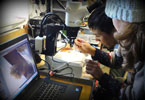CalCOFI instrumentation and measurements have evolved over its 67+ year history. Additional seawater sampling, data collection and measurements are continually being added to the core hydrographic work. Here is a list of the current instrumentation, equipment, and measurements typically required for a CalCOFI cruise:
| Equipment | Org | Location | Ship requirement | Description |
| CTD-Rosette w/ 4-10L bottles | SIO | Quarterdeck | 4500m of ~0.322 conductive wire and winch w/ CTD lab junction box & GPS feed. Surface PAR & SBE 14 remote depth readout box are requested but can be provided by SIO-CalCOFI |
Typical CTD-rosette casts are to 515m (depth-permitting) but a 3500m deep cast may be performed at sta 90.80 & 80.80. |
| pCO2/pH Underway System | SIO | Wet Lab | Uncontaminated seawater, flow rate ~4L/min; GPS feed | Self-contained pCO2/pH data acquisition system collects sea surface pCO2, pH, TSG, GPS data |
| Weather/MET/SCS Underway System | Ship | Ship system | Meteorlogical & sea surface data system & display and/or feed from the ship | Weather and ship's underway data is collected for sea surface measurements and visual observings. |
| ALF: Adv Laser Fluorometer | SIO | Wet Lab | Uncontaminated seawater, flow rate ~1L/min |
Continuous underway analysis of phytoplankton pigment groups and variable fluorescence (Fv/Fm) |
| Bongo Net | NOAA | Quarterdeck | ~500m of ~0.25" hydro wire w/ stainless thimble termination & winch; 75lb weight (NOAA-provided) | Tow specifications: Ship speed ~2kts; using paired 505 um mesh nets w/ 71 cm diameter openings, 300 meters of wire out, depth permitting, descent rate of 50 m/min; then ascend at 20m/min w/ wire angles ~45 degrees. |
| PRPOOS Net | LTER | Quarterdeck | ~500m of ~0.25" hydro wire w/ stainless thimble termination & winch; 170lb weight (LTER-provided) | LTER 210m vertical net tow is performed at all stations on line 90.0 and 80.0 as well as stations out to and including station 70.0 on lines 86.7 and 83.3. Descent rate of 40 m/min, a terminal depth time of 20 secs then an ascent rate of 50 m/min |
| Pairovet Net | NOAA | Quarterdeck | ~500m of ~0.25" hydro wire w/ stainless thimble termination & winch; 100lb weight (NOAA-provided) | Vertical net tow fished from 70m to surface (depth permitting) using paired 25 cm diameter 150 µm mesh nets at stas out to and including 70.0. Pairovet tows require: descent rate of 70 m/min, a terminal depth time of 10 secs then an ascent rate of 70 m/min |
| Manta Net | NOAA | Quarterdeck | ~500m of ~0.25" hydro wire w/ stainless thimble termination & winch; 100lb weight (NOAA-provided) | Using a 505 µm mesh net on a frame with a mouth area of 0.1333 m². Tows are 15 mins in duration at a towing speed of approx 1.5 - 2.0 knots. Wire angles should be kept between 15° and 25°. |
| Secchi | SIO | Quarterdeck | ~500m of ~0.25" hydro wire w/ stainless thimble termination & winch; 100lb weight (NOAA-provided) | Measurements to determine the 1% light level are performed during daylight stations, weather-permitting. |
| Primary Productivity Incubation Experiment | SIO | Main or 01 Deck | Open deck space with unobstructed sun; surface seawater flow ~4+L/min during daylight hours | Each day of the cruise, a primary productivity incubation experiment is started with seawater samples collected from the CTD cast. Eighteen samples are drawn from six calculated light-level depths determined by the Secchi depth |
| Marine Mammal Acoustics | SIO | Main Deck | Empty-spool winch for marine mammal acoustics hydrophone deployments; deck or winch block for wire support, deployment & recovery; GPS feed in dry lab | During transit between daytime stations, a towed hydrophone array, monitored by an acoustician, records marine mammal vocalizations |
| CUFES | NOAA | Main Deck | Ship-provided CUFES system or deck space for NOAA's CUFES 10'x10' van; rail mount for CUFES pump pole and cabling; hull plate mounting bracket. | On Winter (~Jan), Spring (~Apr), and Summer (~Jul) CalCOFIs, the CUFES egg pump filters seawater from a depth of three meters. Seawater is pumped through an egg concentrator and sample are examined, preliminary egg counts are performed, and the samples are preserved for further analysis on-shore. |
| Fisheries Acoustics | NOAA | Ship system | Ship-provided EK60-80 & other frequency data are collected 7/24 | Multi-frequency acoustics are used to estimate the biomass and distribution of mesopelagic and epipelagic (sardine and anchovy) fishes as well as macrozooplankon and identify areas of enhanced productivity and concentration in the southern California Current. |
| ADCP | SIO | Ship system | Ship-provided ADCP data collection 7/24, synced with EK60-80 ping | ADCP continuous profiles of ocean currents and acoustic backscatter between 20 and 500 meters deep are measured along the shiptrack from a hull-mounted 150 kHz Acoustic Doppler Current Profiler (ADCP) |
| Visual Observations | SIO & Farallon Institute | Bridge wings or flying bridge | Bridge or flying bridge space for observers to do visual surveys during daylight transits; request bolted chairs, Big Eye mount, GPS feeds, wind-shield, bimini. What is unavailable can be installed by observers | During daylight transits marine mammal observers and bird observer will visually identify and quantify marine mammals and birds. |


